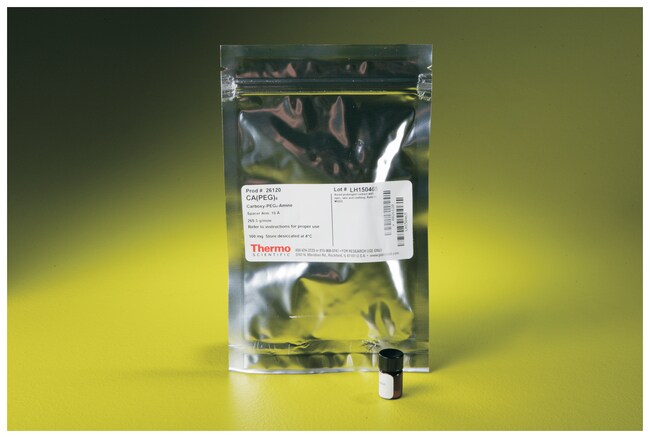
Thermo Scientific Pierce CA(PEG)12 is a pegylated amino acid of the form carboxy-PEG-amine, containing 12 polyethylene glycol units, and is useful for a variety of surface- and molecule-pegylation applications.
CA(PEG)n is the abbreviation for a set of compounds having polyethylene glycol (PEG) spacers with carboxy (-COOH) and amino (-NH2) termini. The unbranched, hydrophilic, discrete-length molecules have the form Carboxy-PEGn-Amine, where the subscript 'n' denotes 4, 8, 12, or 24 ethylene glycol units. The carboxyl and primary amine of each compound provide specific targets for crosslinking and other conjugation methods, making these compounds useful as PEGylation reagents.
Features of CA(PEG)n Compounds
• Fully characterized PEGylation reagents with defined PEG chain lengths; molecules of discrete molecular weight for consistency of performance in protein-modification applications
• Provided as a series of 4, 8, 12 and 24 ethylene glycol units, enabling modification procedures to be optimized for a specific application while retaining all the benefits associated with protein PEGylation
• PEG spacer provides unique advantages, including increased stability, reduced tendency toward aggregation and reduced immunogenicity
• Allows site-specific labeling or crosslinking involving primary amines or carboxyl groups on proteins or surfaces
• Easy-to-follow instructions increase the likelihood of a successful outcome
Applications of PEGylation
• PEGylate carboxyl or amine surfaces
• Add inert mass to proteins, immunogens, drug compounds and probes
• Improve solubility (decrease aggregation) of proteins or peptides without affecting function
• Protect proteins from proteolysis
Methods of Covalent Attachment
• Derivatize or crosslink carboxyls or primary amines using EDC and Sulfo-NHS
• Crosslink amino terminus to primary amines using DSS, BS(PEG)5/BS(PEG)9 or other NHS-ester reagent
• Crosslink amino terminus to sulfhydryl groups using Sulfo-SMCC or SM(PEG)n reagent
Why PEGylate a protein or peptide?
PEG-containing reagents have been used to modify proteins to provide specific advantages. Protein PEGylation can improve the stability of the modified protein, protect it from proteolytic digestion, increase its half life in biological applications, mask it from causing an immunogenic response, decrease its antigenicity or potential toxicity, improve its solubility, diminish the potential for aggregation, and minimize interference for both in vitro and in vivo applications. Polyethylene glycol, also called polyethylene oxide (PEO), has these effects because it is nontoxic, nonimmunogenic, hydrophilic, water soluble and highly flexible.
Advantages of Discrete-length Polyethylene Glycol Compounds
These reagents are specially synthesized, resulting in homogeneous compounds of defined molecular weight, characterized by discrete chain lengths, providing a greater ability to optimize and characterize surface protein modifications. Typical preparations of PEG compounds are heterogeneous mixtures composed of a distribution of chain lengths with a specified average molecular weight or approximate number of PEG subunits.
Related Products
CA(PEG)4 Carboxy-PEG-Amine Compound
| Code | Description |
|---|---|
| 26125 | Catalog Number: 26125 |
| 26124 | Catalog Number: 26124 |

